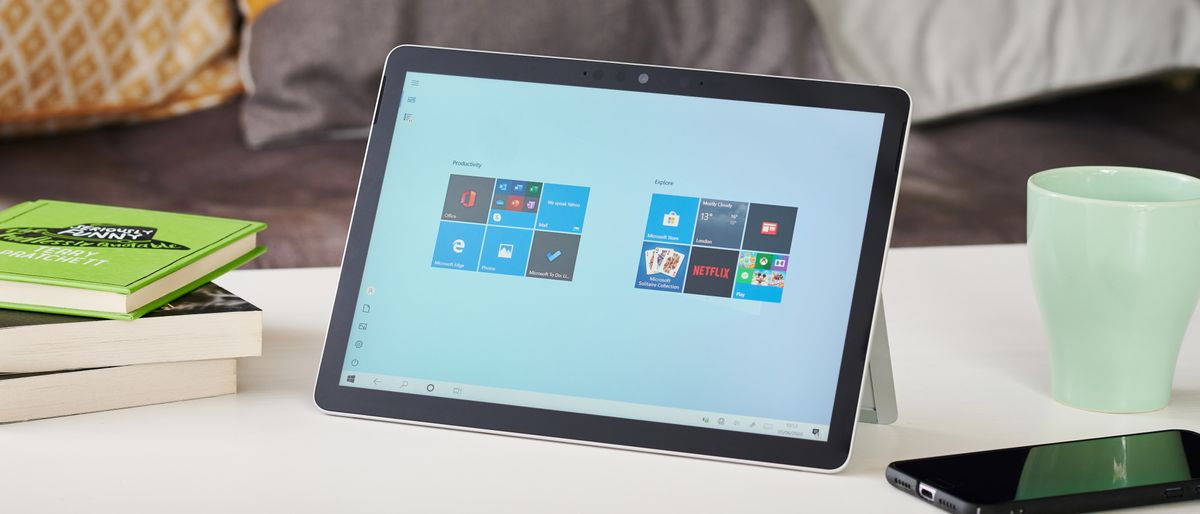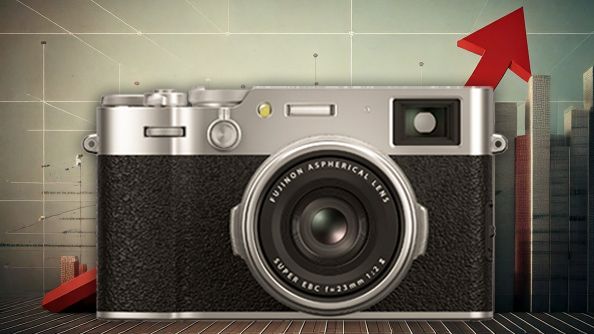TechRadar Verdict
The Microsoft Surface Go 2 is an excellent affordable Windows 10 tablet that features a premium design found in the company's more expensive devices. It offers a slight bump in performance over the original, but it is still rather underpowered – especially the base model. Once you start kitting it out with improved internals and essential add-ons like the Type Cover, the price starts to climb.
Pros
- +
Premium design
- +
Affordable
- +
Can run full Windows 10
- +
Very good battery life
Cons
- -
No Touch Cover or stylus included
- -
Base model's specs are weak
- -
Windows Store still too bare
Why you can trust TechRadar
Two-minute review
It’s not just premium devices that Microsoft can produce. With the Surface Go 2, the company has shown that they can make affordable ones too. This successor to the Surface Go stands out from the rest of the Surface’s more expensive and higher-end offerings by giving those who appreciate the design of the Surface Pro 7 but can’t justify the higher price tag a Windows 10 tablet with a more reasonable price of entry.
And, the Surface Go 2 definitely appeals to the more budget-minded with its starting price of $399/£399/AU$547 for its base model. Of course, it does have some drawbacks. It's pretty underwhelming when it comes to performance, being powered by just 4GB of RAM, an Intel Pentium Gold 4425Y dual-core processor, and 64GB of storage. In fact, that storage space will fill up pretty quickly after installing just a few apps.
Though you can get a more powerful configuration for the Surface Go 2, it’s not going to stand out from the crowd. Additionally, as you go up in power, it will get more expensive, making it much less of a bargain and less attractive to those on a budget. So, while this line does give a more budget-friendly option to consumers, it’s not going to be the best value for those looking for a more powerful tablet. While we hoped that the new Surface Go 3 would have corrected course, it unfortunately doubles down on the weak performance.
The other thing to note is that while you might see photos of the Surface Go 2 with the Type Cover, which not only protects the screen, but includes a keyboard and touchpad for turning the Surface Go 2 into a laptop-like device, these are not included with the tablet. Instead, you need to buy them separately, and that again adds to the overall cost of the product.
When it comes to design, though, we can't fault the Surface Go 2, really. Considering the price, it's got a solid and attractive design, and it's thin and light enough to easily carry around with you and use with one hand.
There's not a huge amount of ports, but the selection is decent enough, with a USB-C port that can also charge the unit. It also has a proprietary charging port as well.
As for performance, the Surface Go 2 was never going to blow us away, but with the version we had it was a competent day-to-day device. If you stick with Windows 10 S Mode, where you're limited to the lightweight apps from the Microsoft Store, you won't have many issues with it.
However, by switching to Windows 10 Home (which is free to do), you can install more complex applications, and it's here where the Surface Go 2's limited hardware becomes apparent. If you choose to do the also free upgrade to Windows 11 (on 8th-gen i5-8350U or i7-8650U processor only), your experience will probably be similar. For casual use, it's fine, but rule out gaming and any intensive tasks like video editing.
Battery life, though, is brilliant, with it lasting over eight hours on a single charge in our tests. This long battery life, along with its thin and light design, and cheap price tag, makes it an ideal device for students who need something to carry around campus, or for anyone who wants an easily portable device that they can sling in a bag without worrying.
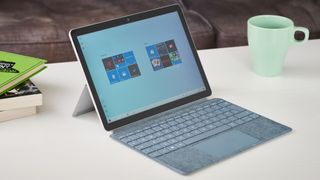
Price and availability
Here is the Microsoft Surface Go 2 configuration sent to TechRadar for review:
CPU: 1.7GHz Intel Pentium Gold 4425Y (dual-core, 2MB Cache)
Graphics: Intel UHD Graphics 615 (integrated)
RAM: 8GB RAM
Screen: 10.5-inch PixelSense (1,920 x 1,280)
Storage: 128GB SSD
Ports: 1x USB-C, combi audio jack, Surface Connect port, Surface Type Cover port, microSSDXC card reader
Connectivity: Intel Wi-Fi 5, Bluetooth
Camera: 5MP 1080p Windows Hello front-facing camera, 8MP 1080p rear-facing camera
Weight: 1.2 pounds (0.55kg)
Size: 9.65 inches x 6.9 inches x 0.33 inches (245mm x 175mm x 8.3mm; W x D x H)
As with the original Surface Go, the Surface Go 2 is an affordable device from Microsoft, and is aimed at taking on Chromebooks when it comes to appealing to students.
This actually makes it a more interesting device than other Surface products, which usually aim for premium and high-end markets. By delivering a good looking, good performing device at a price point far more people can afford, Microsoft is doing something its rivals like Apple and Google often neglect.
The Surface Go 2’s starting price is a very reasonable $399/£399/AU$547. That gets you a device with 4GB RAM, 64GB storage and an Intel Pentium Gold 4425Y dual-core processor.
That’s the kind of spec you’d find in ultra-cheap laptops or Chromebooks, but for a Windows 10 machine, it’s quite weak. The 4GB RAM is just about passable, but don’t go expecting to fire up loads of intensive applications at the same time. That 64GB of storage, however, is going to fill up incredibly fast, especially with Windows 10 installed.
So, if you’re planning on doing light day-to-day tasks, like browsing the web and writing up documents, while sticking with Windows 10 S Mode (which limits the apps you can install on the device to only ones from the Microsoft Store, which are usually very limited), then this model should do the job fine. But for anyone with more ambitious plans for the Surface Go 2, you’ll need to go for a more powerful model.
The good news is that there are plenty of customization options, that could help you get a Go 2 that’s more suited to your needs.
However, the price also climbs quite a bit. So, to double the RAM and storage to 8GB and 128GB respectively, you’ll be looking at paying $549.99/£529/AU$879. This will give you a much smoother experience and a bit more room to store files and documents. It’s also the model we were sent for this review.
In the UK and US, you can also get a model with a more powerful Intel Core M3, which is still a low-powered processor designed for thin and light mobile devices that prioritise battery life and portability over performance.
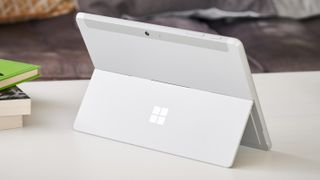
This comes with 8GB RAM and 128GB SSD for $629.99/£619. Strangely, this model isn’t currently available in Australia.
There’s also the same model as above, but with built-in LTE connectivity, which allows you to insert a SIM card and use mobile cellular data for connecting to the internet. This is a really handy feature that means you don’t need to rely on Wi-Fi hotspots when out and about. As long as you have a strong enough signal, you can get download speeds that are just as fast – if not faster – than public Wi-Fi, and it’s more secure as well.
This model will set you back $729.99/£719/AU$1,199.
To get the full Surface Go 2 experience, you’ll also want to buy the Type Cover. This clicks on magnetically to the Surface Go 2, and as well as protecting the screen, it features a built-in keyboard and touchpad. This turns the Surface Go 2 into a laptop-like device, and makes it a much better product for working on. Many people will find this an essential add-on, but you need to pay extra for it – $99/£100/AU$149 to be precise. This is for the standard black cover.
If you want a stylus, then the Surface Pen costs another $78.99/£100/AU$139.95. So, as you can see, this cheap and affordable Surface device can quickly become expensive when you start boosting the spec and adding features many people will feel should be included by default.
There is some good news for owners of previous Surface devices, as their existing Type Covers and Surface Pens will work with the Surface Go 2. So, if you already have them, this makes the Surface Go 2 a lot more affordable.
However, unless you’re happy with the lowest end model, and are going to use it just as a tablet, you’ll find that the Surface Go 2 isn’t quite the bargain it first appears.
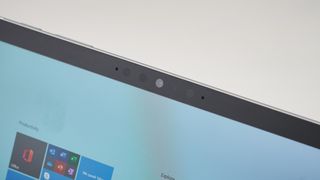
Design
The design of the Surface Go 2 is pretty much identical to the original Surface Go, which means it’s essentially a slightly smaller and lighter version of the Surface Pro. As far as budget devices around this price point go, the design is solid with some premium touches.
The dimensions are 9.65 inches x 6.9 inches x 0.33 inches (245mm x 175mm x 8.3mm) for the Surface Go 2 tablet itself. That’s the same as the previous model, and at 1.2lbs (0.55kg) it’s slightly heavier than the original.
Those dimensions makes it slightly smaller than the iPad Pro 11 (2018), it’s biggest rival from Apple. That has dimensions of 9.74 x 7.02 x 0.23, which means Apple’s device is slightly thinner, and at 1.04lbs (471g), the iPad Pro 11 is noticeably lighter as well.
Still, the iPad Pro 11 (2018) is a more premium product that’s over twice the price of the base model of the Surface Go 2.
One noticeable change with the design of the Surface Go 2 compared to its predecessor is it now has a larger 10.5-inch display (the original has a 10-inch display). That bump in size also comes with a bump in resolution (1920 x 1280 versus the Surface Go’s 1,800 x 1,200), which means the Surface Go 2 doesn’t lose any of the sharpness by going for the larger display. In fact, it now has a slightly higher pixel density of 220ppi (pixels per inch).
It keeps the 3:2 aspect ratio, which means it’s slightly higher than standard 16:9 widescreen screens. The extra vertical space may come in handy for document creation, and as a tablet, the aspect ratio feels quite normal, though in laptop mode you’ll likely notice the difference. When playing widescreen videos, it also means you get black bars above and below the footage.
Port-wise, you get an audio jack for headphones, USB-C port and proprietary charging port on the right-hand side. That charging port is magnetized, which means the charger snaps easily into it. The good news is that the USB-C port can also be used to charge the tablet, so you can use a charger from another device, rather than relying on the Surface Go 2’s charger. It’s a nice, convenient, feature.
Along the bottom of the Surface Go 2 is another magnetized port – this time, it’s to easily snap the Type Cover, if you have one, onto the Surface Go 2. As with previous models, this works well, so there’s no fiddling around to attach the case, and the Go 2 detects the keyboard and touchpad straight away. It’s also easy to remove the Type Cover when you’re done with it, but it keeps its grip so it won’t accidentally fall off.
The power and volume rockers are on the top of the screen, and around the back is a rear-facing camera and a fold-out kickstand. This lets you prop it up on a desk or surface. However, it’s still tricky to use the Surface Go 2 as a laptop-like device on your lap, as there’s still no support between the keyboard and the screen.
The Type Cover is a nice bit of kit, made from a sturdy, yet attractive, material, and the keys are decent enough to type on. The touchpad remains a little on the small side, though.
Still, it makes it more comfortable to write on, compared to the touchscreen. Of course, you can also plug in a USB-C keyboard or attach a Bluetooth keyboard and mouse easily as well.
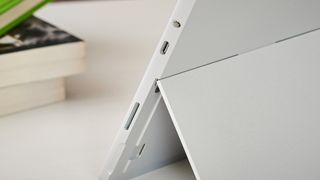
Performance
Here’s how the Microsoft Surface Go 2 performed in our suite of benchmark tests:
3DMark Sky Diver: 3,050 Fire Strike: 814; Time Spy: 324
Cinebench CPU: 335 points
GeekBench 5: 399 (single-core); 963 (multi-core)
PCMark 10: 1,790 points
PCMark 10 Battery Life: 7 hours 40 minutes
Battery Life (TechRadar movie test): 8 hours 25 minutes
Due to the relatively low-powered components in the Surface Go 2, you shouldn’t expect a powerhouse. If you stick with Windows 10 in S Mode, and only use apps from the Microsoft Store, then even the basic model should do fine – though we do worry about that 64GB storage limit.
With 8GB of RAM and 128GB SSD, Windows 10 and its built-in apps ran fine. However, if you want to leave S-Mode and go to full Windows 10, which allows you to run any program designed for Windows 10, you’ll start to see the Surface Go 2 starting to strain. As it would if you do the free upgrade to Windows 11 if you have the i5-8350U or i7-8650U models.
Things like unzipping big compressed files can take a little while, and we’d suggest you forget about running any intensive video editing apps either.
As you can see from our benchmark results, the Surface Go 2 isn’t going to be able to play any but the most basic games either. Of course, you’re unlikely to buy this thinking it’s a gaming device, and you can at least play some casual games from the Microsoft Store if you need a break from work.
So, for basic tasks, the Surface Go 2 runs fine. It’s a similar level of performance we’ve seen in Chromebooks at this price point, but the Go 2 has a slight edge thanks to its ability to switch to the full Windows OS, giving you a much wider range of apps to choose from, compared to Chrome OS on Chromebooks.
As long as you set your expectations appropriately, then you should be reasonably happy with the performance of the Surface Go 2 as a budget device. The newer Intel processors offer a performance boost from the original, and for day-to-day tasks and schoolwork, it does a fine job. Meanwhile, Windows 10 S Mode is more useful than it used to be – as there’s a better selection of apps available on the Microsoft Store.
There are still noticeable absences from the store, however, which means you may want to switch from S Mode to full Windows 10. It’s free to switch, though you can’t switch back. You need to do a full install. Also, you can’t switch one user account to Windows 10 and keep the rest in S Mode. All accounts will then be moved to full Windows 10, which means you lose some of the parental controls and security features.
As we haven't tested the device with Windows 11, we are unable to tell you what you're losing and gaining when switching over to Windows 11 from Windows 10 S Mode. We suggest reading on it first before upgrading.
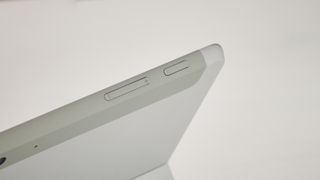
Battery life
While we have some reservations around the performance of the Surface Go 2, there’s one area were it does really impress us – battery life.
In the PC Mark 10 battery life test, which replicates regular use, including video calling, document creation and web browsing, the Surface Go 2 lasted 7 hours and 40 minutes. That’s a pretty good length, and means the Surface Go 2 can last a whole work or school day without needing a charge.
Our own battery life test, where we loop a 1080p, the Surface Go 2 managed an impressive 8 hours and 25 minutes. So, if you’re doing a lot of travelling and want to use the Surface Go 2 to unwind with a few videos, this will last most long haul flights with ease.
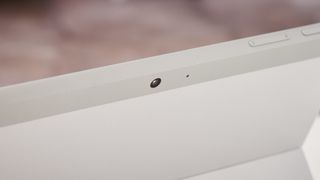
Buy it if...
You want an affordable Windows 10 tablet
The Surface Go 2 is one of the best budget Windows tablets around thanks to its low price and excellent build quality.
You’re a student
Thanks to the Surface Go 2’s price, portability and flexibility, it’s a fantastic choice for students.
You’re after a Windows 10 device for kids
The Surface Go 2 is a good choice for kids as well. Windows 10 S mode offers plenty of parental controls, and they can’t download apps from the internet, offering improved security.
Don't buy it if...
You want a budget laptop
While the Surface Go 2 is a brilliant budget Windows 10 tablet, if you want to use it as a laptop, it means you need to pay extra for the Type Cover. This raises the price above some brilliant budget laptops that you’d be better off buying.
You want a powerful device
The Surface Go 2, especially at its base configuration, is not a powerful device, which means you need to make sure you keep your expectations in check. If you’re after something powerful that can also play games, this isn’t it.
You want the cheapest tablet out there
If you’re after the absolute cheapest tablet out there, then there are much more affordable Android tablets that will do what you need for a lot less. You miss out on Windows 10, but Android has more apps available than the Microsoft Store.
- These are the best laptops of 2020

Matt is TechRadar's Managing Editor for Core Tech, looking after computing and mobile technology. Having written for a number of publications such as PC Plus, PC Format, T3 and Linux Format, there's no aspect of technology that Matt isn't passionate about, especially computing and PC gaming. He’s personally reviewed and used most of the laptops in our best laptops guide - and since joining TechRadar in 2014, he's reviewed over 250 laptops and computing accessories personally.
